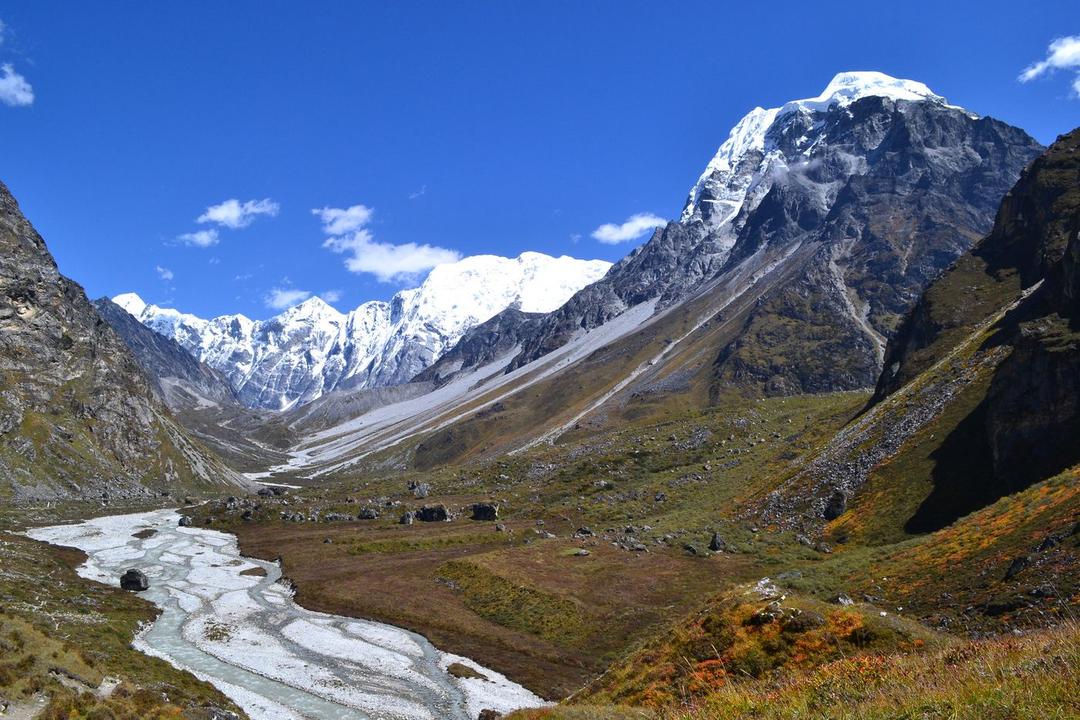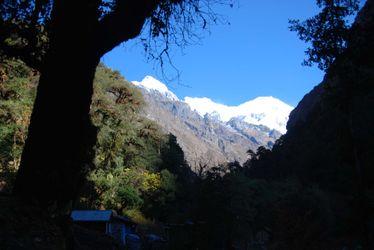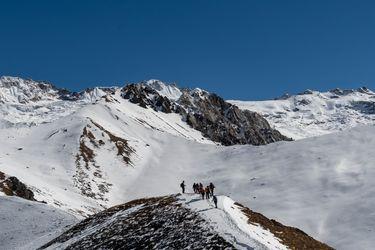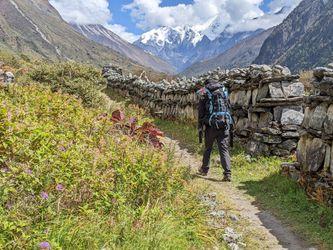Treking Langtang valley
Also known as: Valley of Glaciers





Table of contents
Distances
- 8 - 10 days, 66 km, +4,200 m, 4,984 m high point
- daily: 5 - 7 hours, 6 - 10 km, +400 - 900 m gain
Route
- Out and back
- Starting and ending in Syabrubesi
Cost
- $500 solo
When to go
- March to May
- September to November
Permits
- 1 permit is needed
- costing around $25 total
Guide mandatory?
- no
Accommodation
Teahouses, Lodges, GuesthousesThese are pictures taken while trekking Langtang valley. They're shown here to give you an idea of what the route is like. You're welcome to share your own pictures of hiking Langtang valley, to help the community of hikers. Picture here are either uploaded by members (their own, or creative commons pictures), or guides.
Guide links
Fly to Suketar, Trek to Mitlung (920 m)
Trek to Chirwa (1,270 m)
Trek to Sekathum (1,640 m)
Trek to Amjilosa (2,510 m)
Trek to Gyabla (2,730 m)
Trek to Ghunsa (3,595 m)
Acclimatization Day in Ghunsa
Trek to Kambachen (4,040 m)
Trek to Lhonak (4,785 m)
Trek to Kanchenjunga Base Camp (Pangpema) (5,140 m)
Trek to Ghunsa (3,595 m)
Trek to Sele La (4,290 m)
Trek to Cheram (3,870 m)
Trek to Ramche (Kanchenjunga South Base Camp) (4,580 m)
Trek to Tortong (2,995 m)
Trek to Yamphudin (2,080 m)
Trek to Khebang (1,910 m)
Trek to Suketar (2,420 m)
Fly to Kathmandu
The trek is 4 / 10, based on the below factors:
Treks that involve rugged or uneven terrain, such as rocky paths, scree slopes, or dense forests, may require more technical skills or physical effort.
Considering the maximum altitude reached during the trek. Higher altitudes can present challenges like thin air, low oxygen levels, and potential altitude sickness.
The total distance of the trek. Longer treks generally require more endurance and physical fitness.
Total elevation gain throughout the trek. Treks with significant altitude changes can be more challenging, especially if they involve steep ascents or descents.
Some treks may require basic technical skills like river crossings, using ropes, or scrambling over rocks.
Based on the availability of support facilities such as accommodation, food, water sources, and emergency services. Treks with limited infrastructure or remote areas can be more challenging due to self-sufficiency requirements. The less support facilities there are the harder the trek.
How tough are the prevailing weather and climate conditions during the trek. Harsh weather, extreme temperatures, or unpredictable conditions can add to the difficulty.
Langtang valley weather
How is the weather on Langtang valley, and when is the best time to go.
Langtang Valley's climate is characterized by four distinct seasons - winter, spring, summer, and autumn. The best time to trek the valley is during the spring (March to May) and autumn (September to November) when the weather is relatively stable and dry.
The best time to trek Langtang valley is in these months:
- Mar
- Apr
- May
- Sep
- Oct
- Nov
Langtang valley Gear Packing List
What To Take to trek Langtang valley
- Clothing:
- Waterproof hiking boots
- Lightweight hiking shoes or sneakers
- Lightweight pants
- Long-sleeved shirts (quick-dry material is best)
- T-shirts (quick-dry material is best)
- Thermal underwear (for colder months)
- Waterproof jacket
- Warm fleece or down jacket (for colder months)
- Sun hat or cap
- Warm hat or beanie (for colder months)
- Gloves (for colder months)
- Lightweight rain poncho or umbrella
- Equipment:
- Hiking backpack (40-50 liters)
- Sleeping bag (rated for 0-15°C)
- Sleeping pad or mattress
- Trekking poles
- Headlamp or flashlight (with extra batteries)
- Sunglasses (with UV protection)
- Water bottles or hydration bladder (2-3 liters total capacity)
- Water purification tablets or filter
- Personal first aid kit (including any necessary medication)
- Sunscreen (SPF 30+)
- Insect repellent
- Portable charger or extra batteries (for electronic devices)
- Camera (optional)
- Food:
- Energy bars or snacks (e.g. trail mix, jerky)
- Instant noodles or pasta
- Tea bags or instant coffee
- Rehydration salts (in case of dehydration)
- Other:
- Passport (with visa, if required)
- Cash (in Nepalese rupees or USD)
- Travel insurance
- Map or guidebook
- Copy of emergency contact information
- Toiletries (toothbrush, toothpaste, wet wipes, hand sanitizer)
- Trekking permits (obtained in Kathmandu or at the park entrance)
- Warm sleeping clothes (for colder months)
- Crampons (for snowy trails in winter months)
- Iodine tablets (for water purification)
- Cotton buds (for basic hygiene)
Langtang valley Services
Gear rental, porters, guides, transport, internet, accommodation
Accommodation
Accommodation options include tea houses and lodges which offer basic amenities and a bed for the night.Food
Food is available along the route, with menus featuring mostly Nepali and Tibetan cuisine, as well as some international dishes.Guides
Local guides can be hired for the trek, with prices varying depending on experience and services offered.Porters
Porters can also be hired to help carry gear during the trek, with rates based on weight and distance.Medical facilities
Medical facilities are limited along the trekking route, with basic clinics and pharmacies available in some of the larger villages.Gear rental
Gear can be rented in Kathmandu or at some of the larger villages along the route. It is recommended to bring your own personal gear such as sleeping bags and hiking boots.Transport
Transport options to and from the starting point of the trek include public buses or private taxis. Optional transport methods between places on the route include horse or mule rental.Internet / Phone
There is limited mobile phone signal and wifi connectivity along the route, and internet cafes are only available in the larger villages.ATMs
There are no ATMs along the trekking route, so it is advised to bring enough cash for the duration of the trek.Shops
Shops are available in some of the larger villages, selling basic supplies such as snacks, water, and hiking gear.Langtang valley Accomodation
What is the accommodation like treking Langtang valley
Accommodation options on the Langtang valley trek are basic but plentiful. Trekkers can expect to find teahouses, lodges, and guesthouses along the route, providing a bed for the night and sometimes food and drink. Prices vary depending on location and level of comfort, but most options are affordable.
- Teahouses: These are basic guesthouses that provide a bed and some meals. They are the most common type of accommodation along the route and can cost anywhere from 500 to 2000 NPR per night.
- Lodges: Lodges are slightly more upscale than teahouses and may offer additional amenities such as hot showers and attached bathrooms. Prices for lodges range from 1000 to 3000 NPR per night.
- Guesthouses: Guesthouses are similar to lodges and may offer more amenities. They can cost anywhere from 1500 to 5000 NPR per night.
Langtang valley permits
What permits are needed for treking Langtang valley
1. Langtang National Park Permit
- $25 (~3,000 in the local currency)
- This permit is mandatory for entering Langtang National Park, and covers park conservation, entrance and trekking fees.
- Can be obtained at the Nepal Tourism Board office or at the entrance of the park.
Langtang valley access - getting there
How to get to Langtang valley
- Private Car: It is possible to hire a private car from Kathmandu to Syabrubesi, which is the starting point of the Langtang valley trek. The journey takes around 8-9 hours, and the cost varies depending on the type of car and bargaining skills.
- Public Bus: Public buses leave daily from Kathmandu to Syabrubesi, but the journey can take up to 10-12 hours due to road conditions and traffic. The cost is relatively cheap, but comfort is not guaranteed.
- Jeep: Shared jeeps are available from Kathmandu to Syabrubesi, and are a faster option than the public bus, taking around 7-8 hours. However, the ride can be bumpy and uncomfortable.
- Helicopter: For a more luxurious and efficient option, a helicopter can be chartered from Kathmandu to Lama Hotel, which is further up the trekking route. This option is more expensive, but allows for a quicker journey and more comfortable travel.
- Return: To return from Langtang valley, the same options as above apply, but there are also options to walk to another town and catch a bus or jeep from there. For example, from Kyanjin Gompa, trekkers can walk to Syabrubesi or hire a jeep to take them to Kathmandu.
These are variations on the typical route. Which could be added on; either part way along or at the start / end to extend the trek.
Ganja La Pass
add 2 - 3 extra days
Helambu Trek
add 3 - 4 extra days
Langtang valley questions
What to know about trekking Langtang valley
Common questions people have about this trek, if yours isn’t here - add it to get an answer.
Langtang valley Links
useful websites, Groups and communities
Groups / links with more info on the Langtang valley route.
Use facebook groups to find up to date info, plan trips and find trekking buddies.
These treks are similar in length, difficulty, and elevation. Offering a similar level of challenge as the Langtang valley trek.


